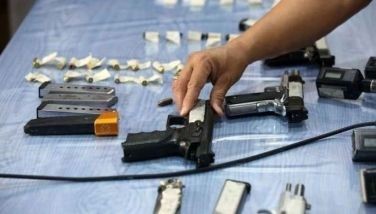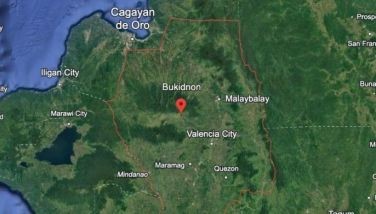New investments pouring into Cebu!

March 5, 2007 | 12:00am
Today is the first death anniversary of my kumpare, Mr. Josefino "Joey" Pineda, who moved from this life to a better one after a five-year coma after he was afflicted with the rare virus Myasthenia Gravis. Joey was a pillar in the Tagalog movie industry. He made movies with his Proteus Films and at the same time sponsored independent films. He was a booker for our family’s theater business. May we ask the pious reader to please pray for the repose of his soul.
If our readers want to know why every now and then I always write about happenings in Balamban, it is not because Tita Rosie Binghay, wife of the Balamban mayor is a relative of mine, but because I have always been a keen observer of Balamban since it became one of Cebu’s hotbeds of the underground Communist movement 20 years ago. In those days, the military and anti-Communists groups in Cebu figured in many clashes with the New People’s Army (NPA) in Gaas town, along the border of Cebu City and Balamban. But those days are gone now.
Today, Balamban is host to the 4th largest shipyard in the world and the biggest in the Philippines and it continues to grow. Last Friday, we trooped to the Marriott Hotel at the Ayala Business Park to witness the contract signing of the phase 4 expansion project of the Tsuneishi (Cebu) Shipyard at the West Cebu Industrial Park in Buanoy, Balamban. This is a $200-million project that would more than double the capacity of Balamban’s current production. That means Tsuneishi would be able build bigger bulk carriers of up to 180,000 DWT. Soon every other bulk carrier that you’ll see in the sea lanes will be manufactured in Balamban, Cebu.
It was just 12 years ago when Aboitiz Construction Group Chairman and CEO Roberto "Bobby" Aboitiz intimated to us that they had a meeting with Makoto Kambara, head of Tsuneishi in Japan, who was planning to build a shipyard in Batangas. But they convinced him to take a good look at the Balamban site and Mr. Kambara fell in love with the place and decided to move there. Three phases later, Balamban has grown so much; it seems that there’s no stopping their rapid economic growth.
It was quite an emotional moment for us Cebuanos to witness the historic signing of this contract to build a new shipway because I know that the money that would be spent on this expansion program would mean more jobs for the construction industry. In fact, my friends from Geo Transport Inc. Manasteel Corp, WTG Construction and Development Corp., were all there at the Marriott to represent the suppliers and subcontractors group. This means that the business trickles down to Cebuano-owned companies.
When the new shipyard is finished after a two-year construction period, you can bet that Tsuneishi would be hiring more shipbuilders to satisfy the world demand for bulk carriers. When that happens, Mr. Bobby Aboitiz told us that they expect annual salaries for Balamban folks to run into billions. This means the people of Balamban will have money to spend for food, clothes, shelter and education for their children.
When I saw Mayor Alex Binghay, I challenged him to create a commercial district for the town of Balamban. That entails proper planning for what could potentially be a new city. In short, they must now make plans to create a new road network with wide avenues. My own personal economic indicator that a town has great economic growth is when it attracts a Jollibee outlet and guess what? This month, Balamban would be opening its first Jollibee outlet.
However, while they are still in the planning stage, perhaps they should also think further ahead about the future of its mass transportation system. Indeed, we are headed to a more stringent clean air environmental controls and that means it is high time we study ways to get rid of that highly polluting tricycle. Since Balamban is not a huge town, it might just be beneficial to use those 8-passenger electric golf carts. Well, I trust that Mayor Binghay can easily do this with the help of the Tsuneishi Shipyard and the Aboitiz-owned West Cebu Industrial Park (WCIP).
Talking about economic growth, Cebu City is also getting new investments. SM Prime Holdings has already started talks in acquiring the 295-hectare South Road Properties (SRP). If this proposal pushes through, SM Prime would assume the full obligations of the P6.3-billion SRP in a joint venture with the City of Cebu. However, Cebu City Mayor Tomas Osmeña isn’t inclined to sell the entire property to SM Prime. Its only other buyer is Bigfoot International, which plans to open up a film studio at the SRP.
No doubt, Cebu is growing a lot faster than other places in this country. Perhaps the only thing that has stagnated in Cebu is our antiquated mass transit system; the venerable jeepney should be phased out and replaced with mini-buses that run on Liquefied Petroleum Gas (LPG) or Liquefied Natural Gas (LNG). With the whole world moving to clean up the environment, now is the right time to make such plans so we can truly progress with the rest of Asia.
However, not all things using the name Cebu have progressed. I’m referring to Cebu Pacific Airlines (CPA), which came into the airline scene by giving customers of Philippine Airlines (PAL) something they never got used to… planes that fly and arrive on schedule. CPA was so successful; they became arrogant and even used PAL’s delays on its TV ads, bragging that its planes are always on time. Unfortunately, those days are over. When Cebu Pacific changed its old (but those planes flew on time) DC-9s and replaced them with brand new Airbus A-319s, passengers now suffer a lot of nasty delays. In fact, the last five times I went to Manila and back to Cebu, my CPA flights were all delayed. No doubt, CPA has retrogressed!
Incidentally, Cebu Pacific has a billboard along Echavez St. corner Mango Ave. which says in Cebuano, "Pinakamaayong Airline para sa Cebuano." Excuse me! Is this what we call "Truth in Advertising?" Mind you, when Cebu Pacific flights arrive in Cebu, they make their announcements only in English and Tagalog. Where’s that distinct "Para sa Cebuano" advantage? Cebu Pacific ought to use Cebuano also; otherwise, they should change the name of their airline because Cebuanos are not happy with them.
For e-mail responses to this article, write to [email protected]. Bobit Avila’s columns can also be accessed through www.thefreeman.com. He also hosts a weekly talkshow entitled, "Straight from the Sky" shown every Monday only in Metro Cebu on Channel 15 of SkyCable at 8 p.m.
Today, Balamban is host to the 4th largest shipyard in the world and the biggest in the Philippines and it continues to grow. Last Friday, we trooped to the Marriott Hotel at the Ayala Business Park to witness the contract signing of the phase 4 expansion project of the Tsuneishi (Cebu) Shipyard at the West Cebu Industrial Park in Buanoy, Balamban. This is a $200-million project that would more than double the capacity of Balamban’s current production. That means Tsuneishi would be able build bigger bulk carriers of up to 180,000 DWT. Soon every other bulk carrier that you’ll see in the sea lanes will be manufactured in Balamban, Cebu.
It was just 12 years ago when Aboitiz Construction Group Chairman and CEO Roberto "Bobby" Aboitiz intimated to us that they had a meeting with Makoto Kambara, head of Tsuneishi in Japan, who was planning to build a shipyard in Batangas. But they convinced him to take a good look at the Balamban site and Mr. Kambara fell in love with the place and decided to move there. Three phases later, Balamban has grown so much; it seems that there’s no stopping their rapid economic growth.
It was quite an emotional moment for us Cebuanos to witness the historic signing of this contract to build a new shipway because I know that the money that would be spent on this expansion program would mean more jobs for the construction industry. In fact, my friends from Geo Transport Inc. Manasteel Corp, WTG Construction and Development Corp., were all there at the Marriott to represent the suppliers and subcontractors group. This means that the business trickles down to Cebuano-owned companies.
When the new shipyard is finished after a two-year construction period, you can bet that Tsuneishi would be hiring more shipbuilders to satisfy the world demand for bulk carriers. When that happens, Mr. Bobby Aboitiz told us that they expect annual salaries for Balamban folks to run into billions. This means the people of Balamban will have money to spend for food, clothes, shelter and education for their children.
When I saw Mayor Alex Binghay, I challenged him to create a commercial district for the town of Balamban. That entails proper planning for what could potentially be a new city. In short, they must now make plans to create a new road network with wide avenues. My own personal economic indicator that a town has great economic growth is when it attracts a Jollibee outlet and guess what? This month, Balamban would be opening its first Jollibee outlet.
However, while they are still in the planning stage, perhaps they should also think further ahead about the future of its mass transportation system. Indeed, we are headed to a more stringent clean air environmental controls and that means it is high time we study ways to get rid of that highly polluting tricycle. Since Balamban is not a huge town, it might just be beneficial to use those 8-passenger electric golf carts. Well, I trust that Mayor Binghay can easily do this with the help of the Tsuneishi Shipyard and the Aboitiz-owned West Cebu Industrial Park (WCIP).
Talking about economic growth, Cebu City is also getting new investments. SM Prime Holdings has already started talks in acquiring the 295-hectare South Road Properties (SRP). If this proposal pushes through, SM Prime would assume the full obligations of the P6.3-billion SRP in a joint venture with the City of Cebu. However, Cebu City Mayor Tomas Osmeña isn’t inclined to sell the entire property to SM Prime. Its only other buyer is Bigfoot International, which plans to open up a film studio at the SRP.
No doubt, Cebu is growing a lot faster than other places in this country. Perhaps the only thing that has stagnated in Cebu is our antiquated mass transit system; the venerable jeepney should be phased out and replaced with mini-buses that run on Liquefied Petroleum Gas (LPG) or Liquefied Natural Gas (LNG). With the whole world moving to clean up the environment, now is the right time to make such plans so we can truly progress with the rest of Asia.
Incidentally, Cebu Pacific has a billboard along Echavez St. corner Mango Ave. which says in Cebuano, "Pinakamaayong Airline para sa Cebuano." Excuse me! Is this what we call "Truth in Advertising?" Mind you, when Cebu Pacific flights arrive in Cebu, they make their announcements only in English and Tagalog. Where’s that distinct "Para sa Cebuano" advantage? Cebu Pacific ought to use Cebuano also; otherwise, they should change the name of their airline because Cebuanos are not happy with them.
BrandSpace Articles
<
>
- Latest
- Trending
Trending
Latest
Trending
Latest
Recommended
January 21, 2025 - 12:00am



























